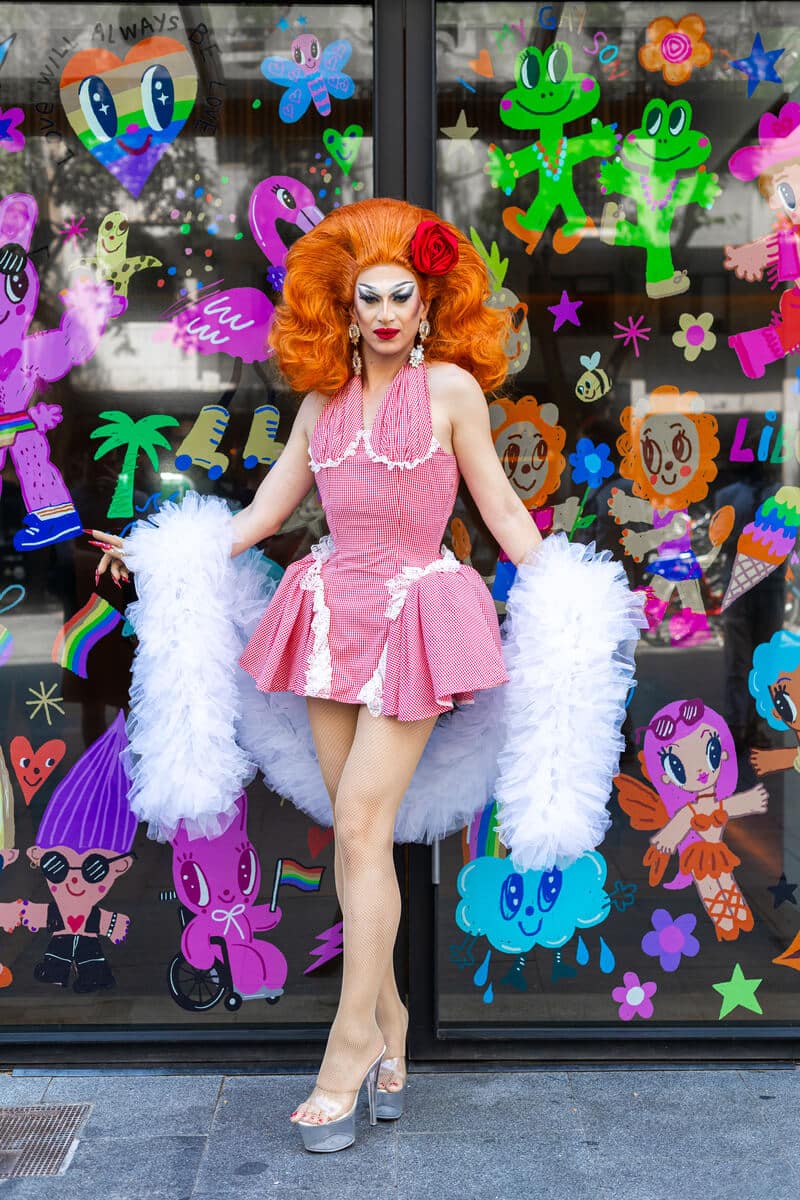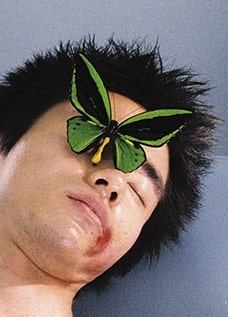Art is always an appropriate response when everything seems too much, and we need a break. More than a break, an escape to a different world where other stories and scenarios are possible, and that is when imagination becomes, ironically, the most human of performances.
That seems to be the realm permeating Ferran Palau‘s work, and more specifically his new album Plora aquí. A collection of songs whose musicality is pure poetry and becomes the point of fusion between costumbrismo and the supernatural. But fear not, in these songs we will find attraction for the mystery and romanticism in his lyrics, we will delight in his impressive and particular relationship with words and sounds, and so many musical landscapes will keep us company on our way to find a bit of our lost innocence.

Nature and creatures are not only the protagonists, but they are also the personifications of emotions, as we find in songs like the first single Aquí no hi ha truc. The tales of the imagination become possible in 120 and Avui, and are embodied in songs like M’encanta, where dreams come to life. According to Ferran, the approach to this new album was like a game where spontaneity and letting himself be carried away by all the techniques learned throughout his career were key, as it’s duly noted throughout the album; innocence and harmless joy play a big part in the album’s narrative, even in its darkest moments. This is an album about a love story and all its chapters take place in another part of the world, fran from the city and into the woods where creatures and mystery are present through a magnificent recreation of sounds. As every story deserves, interludes are here to guide us through the different steps of the journey, and Dinousaures, Snif or Gush gush add a layer of fun and magic to Plora aquí. This album is a special gift, a work that shows its essence in its details, a puzzle that Ferran took the necessary time to make.
Plora aquí is already out on vinyl and cd in physical shops, and the digital release comes this next Thursday, May 23rd, right after Ferran presents the exciting visual side of this project, that plays a central role in this experience. Palau came to the conclusion that the monsters of the films of the 80s and 90s would be the visual focal point of his new work. This idea has been brought to life thanks to the talent of Pablo Maestres and the illustration by designer Dsorder, that along Palau, has been devised with the initial sketches created by himself. Those first sketches have been materialized by the artist Agnès C. Olivé, who along with Andrea Ruiz Pérez and Atena Pou have forged the monsters of this story, Snif and Smosly.
Pablo Maestres directs a super-production in short-film format that accompanies the the album, with the support of the production companies ROMA and SUPERPRIME FILMS and the performances of Bruna Cusí and Judit Mascó. The short film will premiere on 22 May at the Phenomena cinema in Barcelona.
This new album, which was gestated over the course of 2023 in various locations, becomes an itinerant adventure that defies traditional recording conventions. On this occasion, the figure of the producer is blurred, giving way to a more cohesive collaboration between different creative minds. Jordi Matas and Joan Pons have participated in this process, while Mr. Chen has spearheaded the organisation and cohesion of the work. Innercut has also made a decisive contribution to polishing and defining the sonic essence of the album, doing part of the mixing and mastering. May marks the start of a new tour by Ferran Palau and his new band, with concerts confirmed in Madrid, the Basque Country, Zaragoza, Barcelona, Vilanova i la Geltrú, Girona, Tarragona, the Balearic Islands, Valencia, Andorra and Lleida, among other destinations.

We had the chance to talk to the artists about his new album, his upcoming tour, the short film and everything behind its creative process:
Hi Ferran, how are you?
Very well, thank you! Nice to talk to you.
Your new album, Plora aquí, is about to see the light and the public is about to enjoy it, how do you feel after all the work you’ve put into it?
This time I’ve spent more time than usual putting all the pieces together, so I’m really looking forward to the release! I’m really happy with how everything has turned out and I can’t wait to start playing it live.
In the first single Aquí no hi ha truc, we find a declaration of love, which permeates the theme of the whole album, with its edges. How did this song come about, and why did you decide to make it the first thing we could hear from Plora aquí?
The idea when we finished the album was that there would be no singles and that it would come out all at once because for me it’s a compact and indivisible work, but later we decided to release this little preview to accompany the physical release and so that people would have some clue as to what they were buying, because it won’t be on platforms until the 23rd. I think it’s one of the most representative songs on the album and it has that spring essence that’s perfect for the time of year we’re in. As the lyrics suggest, it’s one of those songs that comes out just like that, without having to think too much. Fresh and direct.
Throughout the 13 songs there is a beautiful poetic tone. I wonder if there are any literary or poetic references that have influenced you when composing.
Well, not really. I’ve never been one to read books of any kind, probably because of my dyslexia and poor reading comprehension. I try to see words as small symbols, as material to sculpt, something very plastic. Over the years I have learned to shape my lyrics intuitively without any influence beyond my personal experiences and I think they are still very recognisable today. I don’t know if they have a good literary level, but they work for me.

In the press release you explain that “you have recovered the sense of innocence of your early years with Anímic, when you faced challenges without having a clear path to follow”. How do you usually experience the process of creating your songs in the context of an album?
I had been working steadily for years with my cousin Jordi Matas, polishing this sound that has characterised us so much, but for this album I wanted something a bit more uncontrolled and not so surgical. I tried to think about how I felt when I had no idea how things were done and not to take for granted everything I’ve learnt over the years. So, I approached the record as if it were a game. I recorded in different spaces, with different friends, with all kinds of equipment and mics, things on cassette, sounds on analogue tape, my little digital recorder, etc… Jordi Matas has continued to participate in the album, but the production has been taken over by Mr. Chen, a hip hop producer who has given it that special sound between folk and rap, between lo-fi and hi-fi, with that whole collection of animal samplers and field recordings, with the voice and the beat very much in your face. It’s been a joy to work with him.
M’encanta is one of those songs on the album where nature acts as something beyond a mere stage, it personifies many of its manifestations as feelings. How important and how present has the natural environment been in the creation of the album?
I live in the foothills of Montserrat, a mountain shrouded in many mysteries. From
monsters living in caves, UFO sightings, deaths and disappearances. Not to mention the strange beauty of its forests, so logically my music is impregnated with all that mystery. On this album, for example, I imagined what dinosaur howls must have sounded like among the mountain spires millions of years ago, and I worked on reproducing those sounds to create a sonic horizon for many of the songs. In the lyrics I am very careful with the words I use so that nothing clashes, as if they were a natural landscape that you take care of so that nothing tarnishes its beauty.
Avui transcends its own context to become one of the best songs on the album, an expression of love that may well be a kind of metaphor for the individual journey of overcoming obstacles. There is something fantastic about this track and how as you listen to it this scene is perfectly evoked in the listener’s mind. What can you tell us about the story of this song?
For me it is one of the most special songs on the album on different levels. It is full of parallels with my vision of love and the relationship I have with my wife. Little symbols that give clues and that inspired Pablo Maestres to write the script for the short film that accompanies the album. A love story is glimpsed between two creatures with opposite hearts. One signifies caution and home and the other the appetite for discovering and devouring new worlds. Precisely these two visions of the pursuit of happiness, being opposites, attract each other irremediably.
It is hypnotic to listen to your stories in the songs; it is characterised by this point between the costumbrismo and simplicity in the organic production and a fantastic world where nature plays an essential role. Can you tell us a little about the process of transferring your artistic imaginary to this very personal musical work?
I have a blind faith in the creative process. Over the years I have cultivated a method that focuses on the subconscious and the random. I know that things will come to me if I keep my mind receptive and don’t try to control the situation. There is an energy that makes things fall into place by themselves without having to force anything, so when an idea, a phrase or a melody comes to me I just embrace it because it feels like a gift. As if it happens outside of me and I just pick it up. That doesn’t happen if you don’t work a bit every day because inspiration doesn’t come if it doesn’t see you working. You have to throw the rod out a lot to catch a big fish in a while.


Thinking about the production of the album in general, if we were to compare it to a book of poems, and with the presence of detailed sounds that evoke the supernatural and the hidden life of what could be the living night in the forest, we could say that this case is an illustrated one. How do you approach the inclusion of these musical “drawings” and effects that recreate these scenes?
I try to look beyond the album when I am making it. I mean I need to deploy a whole imaginary to create a little world where all the ideas are going to be able to coexist. It’s like throwing a bunch of pieces on a table and little by little seeing how they can fit together to create a solid castle. I generate all kinds of materials, drawings, photos, videos, sounds, textures, words, and when I have all that, I decide where everything goes. “This works for a cover, this idea I’ll put it in a video…” and so on.
Interludes such as Dinosaures are at times reminiscent of Mastretta’s productions, in Snif there is a very St. Vicent structure, and Es aixi evokes the best and most emotive proposals of Sufjan Stevens. What have been your main musical references since you started composing?
Without a doubt, Sufjan holds a special place in my heart. Then there’s Nick Drake and Vashti Bunyan. I think that’s the core of where my writing and singing comes from but then when it comes to dressing up my sound, I’m much more eclectic and that’s where a hundred things come in. Tyler, the Creator for example has been a big inspiration for years.
Gush gush is a short but beautiful and curious interlude, where we hear the voice of Smosly, one of the main monsters of this story. His voice is pitched, and inevitably I see it as a generational gesture, as if somehow this type of effect in musical production has become a lexical expression. Can you tell us more about the story of Snif and Smosly?
Well, in a parallel dimension, in the forests of Catalonia all kinds of creatures live untouched by human activity. Snif and Smosly are a couple of monsters who live happily together until Snif is attracted to the world of humans… and that’s as far as I can read. With Pablo Maestres, who wrote and directed the short film, over the course of a year and a half we have been creating the overall concept of Plora Aquí and its monsters. I spent some time creating dolls at home and then the textile artist Agnés Costa took over and she designed and built Snif and Smosly with her team, and with the ideas that we collected.
You are immersed in the beginning of a tour that will take you to different cities around the country, how are you and the band planning to take these songs live?
When recording albums, I never lose sight of the fact that these songs will continue to grow in the live show, so I try not to let one format be a limitation for the other, creating with complete freedom and letting the music be alive at all times. For the tour of this album, I have made changes in my band and I am very happy with how we are sounding.



According to the Music Yearbook 2023 of the Professional Association of Representatives, Promoters and Managers of Catalonia (ARC) and the Enderrock Group, the music industry in Catalonia has achieved its best results last year. As an independent artist, how do you feel that this new musical ecosystem of festivals and macro-festivals works for you and other artists with similar experience?
In Catalonia, live music has always been very well cared for throughout the length and breadth of the territory. There are people who, with all the love in the world, set up their own cycles, festivals and programming in bars and venues of all kinds. So, an artist like me can do a lot of concerts in a single tour. I don’t think the ecosystem is new, but little by little the work and perseverance of so many people who are passionate about music is being noticed.
Undoubtedly, Catalonia is a pioneer and part of the most avant-garde music coming out of our country. Who are your favourite artists/companions?
Well, if we’re talking about avant-garde, we have the electronic duo B1N0, who have just released a crazy album, and the unclassifiable Marina Herlop. Still, if my instinct doesn’t fail me, after a hyper technological era very focused on digital, urban and fast consumer sound, the trend will be to return to more natural and organic sounds and in this sense Mar Pujol or Núria Graham achieve all that without ceasing to be radically contemporary.
I would like to ask you about an essential part of this work, which is the short film directed by Pablo Maestres, which accompanies the album, and which will be premiered on 22 May at the Phenomena Cinema in Barcelona, the night before the official release of the album on digital platforms.
Well, as you say, it’s the other half of this project that uses the imaginary of the endearing monster films of the eighties and nineties to create a love story with many nuances and that ends up being a critique of the fast consumer society we have become. Pablo is undoubtedly a genius in the sense that he pushes his art to the limit, often at the cost of his mental health, so I couldn’t be more grateful to be living this dream alongside him. Few artists I have met who are so committed to their work.
Why was it important to translate the album visually in such a cinematic way?
Because that’s how Pablo and I see art in our heads, in a big way. Most of the time I can’t find the means to do everything I can think of, that’s why this time Pablo’s work has been so important, along with the production of Roma and Super Prime and the support of my label Hidden Track Records. There are hundreds of artists and technicians involved in this project and I can never thank them enough for their commitment and dedication.
Ferran, thank you very much for your time, all the best with this new album!
Thanks to you!

Follow him @ferranpalau
Interview by @Awerpower







































